
No matter who you are, Vietnamese or foreign tourists travel to Vietnam, I strongly believe that noone won’t be interested in these things about the H’mong if they have chance to join actual travel tours to where the H’mong live.
Unique Architecture of the H’mong
With cold and harsh climate high in the mountains, it is most suitable for the H’mong people to live in houses with earthen walls, and bake d tile or thatch roofs, which keep the space warm in winter and cool in summer.
Geographic conditions have strongly influenced H’mong architecture. All houses have the same shape regardless of their size: three chambers and two doors. In the house, the left chamber (from the entrance door) is the kitchen and bedroom of the host and hostess; the right chamber has the fireplace and a guest bed; and the centre is the ancestor chamber where guests are welcomed and the family has meals. The houses always have several shelves to store household utensils and foods (maize, rice and beans). Shelves are also broad enough to function as beds for guests.

The H'Mong House
To select land to build a house, H’mong ethnic minority people put three rice seeds on the land which they choose and turn a bowl or wood basin over, then burn three joss sticks and three tissue papers, which represents the master of the families petition to the gods of the kitchen and soil to build a house. After three months they come back to see whether the three rice seeds are intact or not. If the rice is undamaged by ants or insects, the land is good for building house. After finding suitable land, H’mong people start clearing the site, walling and balancing the foundation. The work of walling is quite complicated with a number of strict customs. For example, during the process of walling, strangers, particularly women, are not permitted to get close. Workers fill in wood frames with soil which has been cleaned of roots, leaves and rocks, and ram down the soil. After walling, H’mong people choose a straight timber from the forest and immediately put it on top of the house without allowing it to touch the land. H’mong people consider it the main column of the house as a reflection of the master’s straightforward and firm character. Thus, the chosen timber must be not bored by insects and not lopped in the top. The main column plays an important role in H’mong people’s spiritual life.
Traditional Costumes of the H’mong
While H’mong house construction is relatively homogeneous, their traditional clothes vary, particularly those of women. H’mong costume has its own character in colours and patterns compared to traditional costume of other ethnic groups. The cajuput colour on H’mong linen is more sparkling than that on cotton cloth. H’mong clothes are often colourfully decorated, revealing the vitality of the mountainous area. H’mong traditional costumes are also decorated with silver jewellery like ear rings, rings, necklaces and key chains.
The wide creases on H’mong women’s skirts make them a truncated cone shape. The skirt of White H’mong women are made of linen, while women of other H’mong groups wear cajuput coloured skirts with an embroidered fringe. Besides clothes, H’mong women also wear artificial hair to make them more charming. H’mong girls keep their hair long until getting married. The married women gather their hair into a bun on the top head and use a hairpin made from hoof of horse to keep it up.

White H’mong women clothes
It’s also quite difficult for tourists who travel to Vietnam to identidy traditional clothes of White H'mong in different places.
White H'mong of Thuan Chau and Tuan Giao. Some H'mong women can still be seen wearing the traditional white skirt but most opt for the black trousers worn under a black apron and black jacket with distinctive blue circles around the lower sleeves. This is often worn with a plain black headscarf decorated with tassles.
Further north, the White H'mong of Sin Ho are distinguished by their tall peaked black turbans from which may hang a scarf. Some H'mong ladies also wear a white pleated skirt over which is suspended a black apron.
The White H'mong of Northern Tuyen Quang Bac Can and Southern Cao Bang Provinces is subtly different from that of the White H'mong elsewhere. The black apron which covers the black pleated skirt has no vertical coloured stripes but is tied in place by a wide floral or embroidered belt, whilst the black jacket has wide bands of coloured material around the sleeves and is characterised by a distinctive collar of thick embroidered material which extends over the shoulders to form a large rear panel. The outfit also features a black and white chequered headband which is worn together with a patterned scarf.
The White H'mong of Tam Duong usually wear a black or blue jacket with concentric red embroidered panels and a thick red or floral belt.
The most notable feature of the Red H'mong women of southern Lai Chau is their distinctive 'big hair' achieved by carefully collecting all the dead hair that falls out and weaving it into the living hair. Their traditional costume features a pleated skirt of indigo batik with a particularly beautifully embroidered border, worn under a black apron with a red/floral waist band and a black jacket with large embroidered lapel panels at the front and concentric circles of blue and floral material at the lower sleeves.
Flower H'mong of Lao Cai Province are undoubtedly the most colourful of all branches of H'mong to be seen in Vietnam. They wear a colourful embroidered calf length skirt together with a highly embroidered jacket with a clasp under the right shoulder. Although also seen around Tam Duong, you will be jostling with hundreds of these ladies if you venture to Bac Ha market on a Sunday.
The Black H'mong women of Sapa are instantly recognisable - by their sheer weight of numbers and their distinctive black indigo skirt and shirt. Usually a long black waistcoat is worn over the shirt and a black pillbox hat is worn on the head. The ensemble is completed by black leg warmers.

Black H'mong women
Unlike women, H’mong men of different groups wear similar clothes. They put on trousers, short-sleeved shirts, rope-belts and headscarves. Male trousers have one long leg and one short leg. Black H’mong men dress in short shirts, with the front not enough to cover the chest and long sleeves decorated with colourful fabrics. White H’mong men wear tight-sleeved, round-necked shirts. Flower H’mong men dress in collar-less shirts which have side buttons (along the arm), and wear scarves on their head and neck in winter. They also put on necklaces, bracelets and rings during festivals and market days.

Black Hmong Boys In Traditional Clothes in the fog
Hmong Boys In Traditional Clothes
Dong Van, Quan Ba and Meo Vac districts in Ha Giang province are home to 180,000 H’mong people, who live harmoniously on basic economic activities, handicrafts, animal husbandry and horticulture.



.jpg)






(84-63) 3 826042 – (84-63) 3 511142
No 54 Nguyen Dinh Chieu, Ham Tien Central Mui Ne Beach Binh Thuan Vietnam
523 To Hien Thanh District 10 Ho Chi Minh City Vietnam
Ha Long Halong City Quang Ninh Vietnam
A13 Hung Thong 2 Halong City Quang Ninh Vietnam




